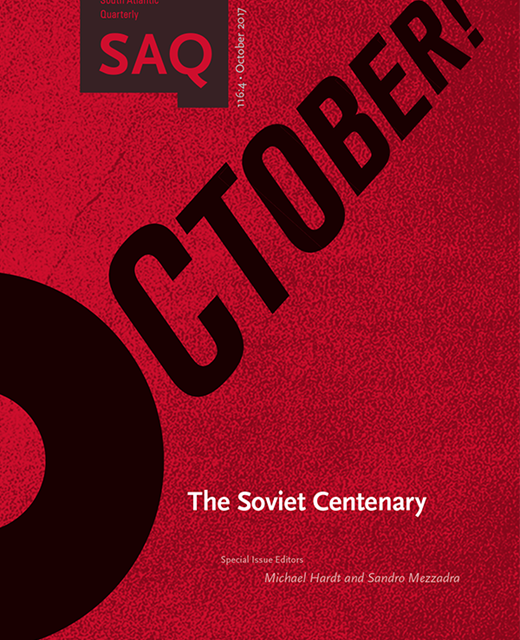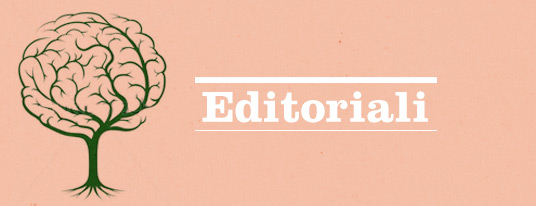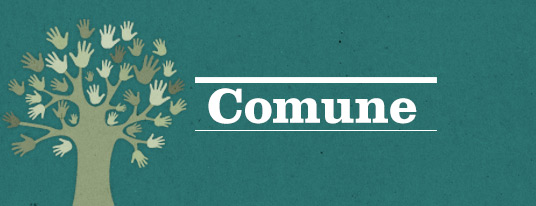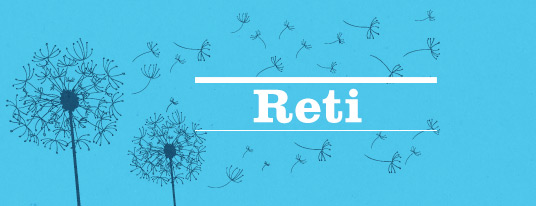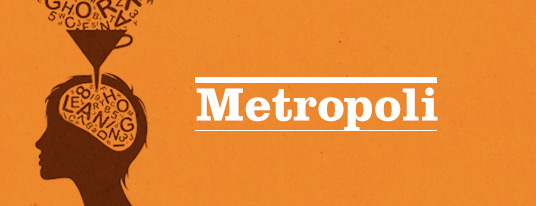di MICHAEL HARDT.
(è stato pubblicato il nuovo fascicolo della South Atlantic Quarterly, vol. 116, n.4 – October! To commemorate the Future – numero curato da Michael Hardt e Sandro Mezzadra e dedicato a riflessioni sul tempo attuale alla luce della Rivoluzione. Dopo l’introduzione dei curatori [qui], i testi di G. Amendola [qui] e T. Negri [qui] pubblichiamo, grazie alla cortese autorizzazione della rivista e dell’editore, il testo di M. Hardt – EN).
A true revolutionary, Che Guevara declares, must be guided by strong feelings of love (year: page). Alexandra Kollontai, Bolshevik revolutionary and Minister in the first Soviet government, would ultimately agree, but the first task is to critique and destroy the forms of love that now predominate. In line with feminists such as Mary Wollstonecraft a century before her and Shulamith Firestone decades after, Kollontai recognizes that love – particularly heteronormative romantic love and family love – serves as a trap for women and a structure that guarantees their subordination.1 The dominant forms of love in contemporary society, furthermore, are socially limiting and politically harmful, for men and women alike. The root of the problem, Kollontai claims, is what I call property love, that is, the fact that we regard our bonds to each other in terms of ownership and property relations.2 The distinctive feature of Kollontai’s position, then, is that the critique of love is inherently a property question and thus that overcoming property love requires not only equality – equal property, for instance – but a radical social transformation, an explicitly anticapitalist project. Only once property love is abolished can we begin to invent a new love, a revolutionary love, a red love.3
During the first decade after the October Revolution, a period of intense cultural, artistic, social, and political experimentation, several intellectuals explored how deeply property relations are insinuated into every aspect of social life, well beyond the economic sphere. And they sought, by unearthing and eradicating property relations from all corners of society, to imagine how a new society could be built. In effect, they experimented with and extended Marx and Engels’ claim that – “the theory of the communists can be summed up in a single sentence: the abolition of private property” (Marx and Engels 2008: #). In this regard, Kollontai’s analysis of property love in the couple and the family is parallel, for instance, to Evgeny Pashukanis’s critique of law and the state, developed in the same years.4 Pashukanis argued that modern juridical and constitutional concepts are based ultimately on property and commodity relations. Abolishing property relations, then, he reasoned, would necessarily undermine state sovereignty and require a complete reformulation of the basis of normativity and law (see Amendola in this volume). Just as for Pashukanis the abolition of private property in communist society directly implies the withering of the state, for Kollontai it entails the withering of the bourgeois couple and family.
It might be tempting to read Kollontai and Pashukanis in a traditional structure-superstructure framework, assuming, in other words, that elements or characteristics of the economic base of society are primary and reflected, secondarily, in the ideological and cultural spheres. But property, in their arguments, is not merely an economic category: it is from the beginning a logic and a mode of relation that spans all realms of life. One cannot simply aim for the abolition of property in the economic relations, then, and assume that other social realms will follow suit. Instead the struggles against property relations must proceed in parallel in all social domains. And in each social domain one must invent an alternative. What is a subject not defined by its possessions? What is a legal relation not founded on property? And what can love be when free of the logic of possession and ownership?5
Property love
The logic that binds the modern couple, Kollontai asserts, is based ultimately on property relations. In pursuing this critical claim, she is certainly concerned, as are many other feminists, with the gendered right to ownership and inheritance of material wealth, but her argument stresses more strongly a different insight: that we regard our bonds to each other in terms of property and possession. In capitalist society even romantic love is a property relation. “You are mine” and “I am yours” are emblematic of the pledge of love as property. Consider, Kollontai explains, the experience of two people who, soon after falling in love and forming a couple, exert rights over the other’s relationships, including even those relationships begun before they knew each other. It would be regarded as lack of trust or, really, a breach of property rights to refuse to share any experience past or present, any friendship, past lover, or family relationship. The mistake of many women in particular, she explains, is to believe to have found the person with whom “we could blend our soul” (Kollontai 1971: 8). Everyone keeps some secrets and insists on some independent friendships, but those are the exception because the social norm, the regulative ideal of romantic love, requires that when you enter into a couple you give yourself over and expect the other to do the same in return.
Property love was not always the norm, at least not in the same way and to the same extent. In premodern European society, Kollontai claims, men took possession of women’s bodies and women were obliged to be faithful to men physically (economically and sexually), but women’s minds and souls were to a large extent their own. In bourgeois society, however, she continues, the love-property relation shifts and deepens: “It is the bourgeoisie who have carefully tended and fostered the ideal of absolute possession of the ‘contracted partner’s’ emotional as well as physical ‘I’, thus extending the concept of property rights to include the right to the other person’s whole spiritual and emotional world” (1977c: 242). In addition to the inequality and the subordination of women created by bourgeois property rights in the couple and family, then, the possession of the other – the fact that love requires you to give all of yourself as property – adds another layer of unfreedom.
It may seem incongruous to claim that modern love is a property relation since the standard historical account maintains that modernity freed love from property, doing away with arranged marriages, primogeniture inheritance laws, and eventually, legal structures that designate women as the property of fathers and husbands. Although most life decisions must be made with regard to property interests, according to this view, there is at least one realm in life, the intimate sphere of the couple and the family, where decisions are made on the basis of love. Modern novels are full of narratives, for instance, in which choosing a partner against the pressures of property interests – Rochester chose Jane Eyre, after all – demonstrates the triumph and autonomy of love in the intimate sphere. The realm of love, the thinking goes, is the one place free of property, a space of the common where we share money and goods. Kollontai’s argument, in contrast, is that even when legal designations of property are not involved today, we still conceive our intimate bonds according to the logic of property relations, as a form of ownership and possession. Kollontai, in this sense, gives new meaning to Marx’s claim that private property has made us so stupid that we can only think of something as ours when we own it (Marx 1974: #).
One consequence of love being configured as a property relation is to make the couple a “complete” and thus isolated unit. By the logic of property love, Kollontai reasons, since you have right only to what is yours, bonds with all those outside the couple must be subordinated. “I am yours” thus goes together with “you are everything to me.” Indeed, complementarity and wholeness are standard clichés of romantic love: the two lovers are missing puzzle pieces who complete each other and together form a whole. Sigmund Freud reports this standard view of the couple as a kind of scientific fact: “The more they are in love, the more completely they suffice for each other” (Freud 1959: 72). For Kollontai, however, the complementarity and the resulting isolation of the couple is neither natural nor desirable. Such complementarity negates freedom inside the couple. Insofar as you exist for the other, oriented to your other half, you become a limited and partial person. “The individualistic property morality of the present day is beginning to seem very obviously paralysing and oppressive” (“Sexual relations” 1921, p. 240). All the existing and potential aspects of yourself that do not function as complement to the other – all the pieces that do not fit in the couple puzzle – must be set aside or subordinated.
Kollontai is more concerned, however, with the external restrictions of the “complete” couple. “The ideal of the bourgeoisie was the married couple, where the partners complemented each other so completely that they had no need of contact with society” (1977b: 230). Since the two suffice for each other, the couple severs or fails to establish social ties. (How often have you had a friend disappear after falling in love, ensconced in a “complete” couple, only later to reappear again to renew your friendship once the couple breaks up?) The couple, in effect, fulfills the bourgeois ideal of the sovereign individual, internally unified and self-sufficient, acting according to extended egotism, an egotism masquerading as altruism, making decisions according to what is best for the two. As Nietzsche, an unlikely ally of Kollontai, writes, “Love of one is a barbarism: since it is practiced at the expense of all others” (Nietzsche 1973: 72). Couple love, like property love in general, discourages and even prohibits caring for and forming bonds with what is not yours.
The glass of water theory
Kollontai’s challenge to the antisocial couple bound by property relations inevitably raises a series of straw man arguments and panic reactions regarding sex. If the two are not bound by mutual ownership in property love, according to such fears, then anything goes, raising the specter of “free love” and polyamory. We need to reduce the focus on sex, however, to appreciate Kollontai’s argument about love.
In the early 1920s, Soviet revolutionaries debated the glass of water theory of sex, a theory widely attributed to Kollontai.6 Having sex, the theory goes, should be no more complicated or problematic than drinking a glass of water. The glass of water theory, however, simple as it is, proved difficult for many to understand. Whereas, perhaps predictably, the metaphor generated for many heightened focus on sex – along with titillation and panic regarding casual sex and multiple sex partners as well as disapproval for violating traditional morality – it was intended, to the contrary, to sideline such excited discussions. Since having sex, like drinking water, is a normal bodily function, it should be neither subject to moral injunction and social control nor the object of political celebration.
The glass of water theory would likely be equally misunderstood today, since it does not conform easily to established political positions regarding sex, especially those we have inherited from the “sex wars” of the 1980s. The theory certainly does not fit, for example, with either what came to be cast as sex negative positions (which arose in part to highlight the damages accrued to women in and by pornography and the sex industries) or sex positive ones (that advocate in contrast sexual freedom and the liberatory character of non-normative sex practices). Whereas both sex negative and sex positive positions agree that sex is important politically and socially, the glass of water theory maintains it is not.
The glass of water theory proves so difficult to grasp in part due to its paradoxical rhetorical strategy: it brings something to light in order to diminish its significance. Its intended function is thus subtractive. In its rhetorical strategy, the glass of water theory resonates with the social interventions of the ancient Cynics, such as, for example, their reported practice of masturbating in public. No one should be scandalized, they argued, by us satisfying a bodily need that is of the same order as satiating thirst or hunger. If only it were as easy, Diogenes of Sinope allegedly declared, to banish hunger by simply rubbing my belly! Diogenes’s point is obviously not to concentrate political or philosophical attention on masturbation, to celebrate it, or to create an onanist cult. On the contrary, the point is subtractive: to release us from preoccupations about sex so that we can direct our attention elsewhere.7 That is the function of the glass of water theory: stop being distracted by sex so as to focus on the important social and political issues.
This raises, however, another obstacle to understanding the glass of water theory today: that it could appear to assert that sex is personal and thus not political, running counter to the important second wave feminist slogan. Furthermore, it could mask the sexual dangers women face, including unwanted pregnancy, rape, other forms of sexual violence. I understand the glass of water theory, however, as positioning sex as political but imagining it in a society of freedom, where sexual violence, unwanted pregnancy, and the constraints of normativity and moralisms are a thing of the past. In effect, the theory is a demand for that utopian future, in which having sex can become no more complicated that drinking a glass of water.
Although likely not responsible for the idea, Kollontai is a good representative of the glass of water theory. She was regarded by others and indeed presented herself as embodying the new liberated woman. The characters in her novels, such as Red Love, experiment freely with various amorous arrangements. And in her life too she reports treating sex openly and without moralisms: “I make no secret of my love experiences,” she explains in her autobiography, “when once love came, I have my relations to the man.” (Kollontai 1971: 5 – how to deal with punctuation?) By demystifying sex, she sought to counter the moralism, prohibitions, and shame associated with sexual activity in traditional Russian society, which served as weapons for the domination of women. And she lamented that asceticism regarding sex, often mixed with traditional moralism, remained widespread even among Soviet revolutionaries: “My theses, my sexual and moral views, were bitterly fought by many Party comrades of both sexes.” (Kollontai 1971: 43).
Lenin is one who was puzzled and a bit disturbed by all the discussions of the glass of water theory. “Of course,” Lenin admits, in conversation with Clara Zetkin, “thirst must be satisfied. But will the normal man in normal circumstances lie down in the gutter and drink out of a puddle, or out of a glass with a rim greasy from many lips?” (Zetkin 1934: 49). The first sentence shows that Lenin, even if he thinks he is disagreeing, understands correctly the primary point of the glass of water theory: sex like thirst is a normal bodily function and thus should be stripped of the traditional meanings and values attached to it. But then he seems to take the metaphor too literally and betrays traditional male fears of “polluted” women. The idea of women having multiple partners and casual sex elicits a kind of panic in Lenin. But if one can filter out Lenin’s fear of female sexuality, then perhaps his question can be understood as simply an extension of the initial point. Stripping sex of moralism does not imply having sex indiscriminately, indifferently, Lenin seems to suggest. Instead, sexual activity, like drinking water, should be treated in terms of care of the self – take care of your body and meet its needs. Maybe food, then, would be a better metaphor than water for Lenin. Nutritionists may offer general guidelines for a healthy diet but each has to discover the needs of one’s own body in balance with pleasure: discover what sex, how, how often, and with whom, agrees with you and pursue that, avoiding what harms you. No model of healthy sex can be prescribed for all, in other words, but neither is it a matter of indifference. Communism is no asceticism, Lenin adds, to make sure that Zetkin does not misunderstand him: healthy sex, along with sports and other activities, is part of a joyful life.8
Lenin is clear, however – and this too, I would argue, is in line with the spirit of the glass of water theory – that these questions about sex are not the most significant social and political issues. “But the social aspect is most important of all,” he continues. “Drinking water is of course an individual affair” (Zetkin 1934: 49). Lenin may still be taking the metaphor too literally: sexual activity, after all, is not like drinking water in all its aspects. But the substance of Lenin’s point – that the social aspect is most important – is, in fact, very close to Kollontai’s primary concerns.9 “It is time to recognize openly,” she writes, “that love is not only a powerful natural factor, a biological force, but also a social factor. Essentially love is a profoundly social emotion” (1977f: 278). Sexual relations alone, inevitably, regardless of how many sexual partners one has, remain asocial in Kollontai’s terms because sex itself is too narrow a basis to carry the multiplicity of bonds that love must generate and sustain. The important question for Kollontai is how to create a variety of lasting, social bonds (involving sexual relations or not) that are not constituted by property relations. Only in that way can we can begin to explore the social significance and political possibilities of a new love.
The antisocial family
The nature of property love in the couple is repeated in the family, creating what Michèle Barrett and Mary McIntosh call the antisocial family. Like the couple, according to Kollontai, the family becomes in capitalist society an isolated unit more completely closed on itself. The regulative ideal requires that you devote your love most to your kin, and then to others in concentric waves extending outward from the family. The resulting assumption that family members love each other most and thus should have the most right and responsibility is inscribed in a series of legal structures and customary practices. (Hospital nurses are trained to stop you at the loved one’s sickroom door: “are you family?”) Kollontai cites the fact that Aspasia, the mistress of Pericles, “was respected by her contemporaries far more than the colourless wives of the breeding apparatus” as evidence of bonds outside the family in other societies, which have been lost or weakened today (1977e: 262).
The antisocial and possessive nature of the family and its extended egotism are even more pronounced in decisions regarding children. Kollontai laments and mocks the typical proprietary attitude of parents: “These are my children, I owe them all my maternal solicitude and affection; those are your children, they are no concern of mine and I don’t care if they go hungry and cold – I have no time for other children” (1977d: 259). Ownership, as the ideologues of private property will tell you, comes with responsibility: you are obliged to care for what is yours. And, consequently, tending to the property of others – in this case caring for their children – is not only not required but would be a violation of property rights, just as if you were to decide to paint over the hideous color of your neighbor’s house. As much as property love requires you to care for what is yours, it discourages or even prohibits you from caring for what is not.
Property love in the couple and the family is parallel to (and often bleeds into) identitarian love on the political terrain. Limiting love to what is “yours” is another face of the love of the same. Love in the couple may seem on the surface to be aimed at someone different, but once the two are conceived as complementary and the couple a “complete” whole, then two collapses back into one. The family too, with the proprietary conception of my children and my spouse, is a unit of identitarian attachment. Property breeds love of the same.
Here, yet again, arise straw man arguments. Destroying the antisocial family – and moreover destroying the property-based love on which it rests – does not mean stripping children away from their parents to be raised collectively. Nor does separating love from property, no longer loving only what is yours, mean loving all indifferently. One could certainly interpret as indifference Kollontai’s mandate, after critiquing parents who act in the interest of only their own children, that “the worker-mother must learn not to differentiate between yours and mine” (1977d: 259). Such statements, however, have to be read together with her encouragement to develop many and varied bonds of love and friendship. The point is that the couple and the family should not be the limits of your love. Loving other children, caring for them, and making social decisions with their welfare in mind need not prevent you from loving your own. “Caring, sharing, and loving would be more widespread,” Barrett and McIntosh argue, “if the family did not claim them for its own” (1982: 80). You can construct lasting bonds of various types with those close and far. Challenging property-based love, then, requires breaching the boundaries of the couple and the family, nurturing and developing modes of social love based not on sameness but on difference, and inventing social institutions that allow and encourage us to love and care for others in the widest possible frame, developing a wide variety of social bonds.
Kollontai claims – with a mix of description, prescription, and hope – that the family, as an antisocial institution of gender subordination and property bonds, began to be undermined in capitalist society and will further wither away in communist society (1977d: 258). The withering and eventual abolition of the family are steps towards the equality and freedom of women, releasing them from the isolation and burden of domestic labor and subordination of familial gender hierarchies. In capitalist society, she explains, the family was initially an economic necessity as a unit of both production and reproduction. The production component has already been all but destroyed by capitalist development: the domestic industries, such as spinning yarn and making clothing at home, were rendered obsolete by processes of commodification and the creation of new markets for capitalist goods. “The family no longer produces; it only consumes” (1977d: 254). In communist society, she predicts, the economic bases of the sexual division of labor in the family will be weakened, women will no longer be responsible for unpaid domestic labor, and reproductive labor in the home will be socialized: she envisions restaurants and canteens providing food for all; childrearing will be socialized; and the fatigue of domestic tasks, such as washing and cleaning, will be reduced with industrial appliances (1977d: 255).
Kollontai, particularly in her role as Minister of Social Welfare, took some practical steps to hasten the withering of the family in the Soviet Union. She participated, for instance, in drafting the 1917 law on marriage, which gave women the right to seek divorce and receive alimony. For the 8th Party Congress in 1919, Kollontai prepared an amendment to affirm in explicit terms the withering away of the family, but Lenin, although sympathetic to her aims, claimed that it was not yet the right time: “we have in fact,” he is reported to have responded, “to save the family.”10 As minister she proposed a series of institutional women’s health initiatives, such as having the state take over maternity hospitals and the provision of pre-natal care. These proposals, however, were meet with great resistance, even among the most forward-thinking Soviets. “My efforts to nationalize maternity and infant care set off a new wave of insane attacks against me” and detractors claimed she was trying to “nationalize women” (Kollontai 1971: 38).
Kollontai’s efforts to destroy the antisocial family were thwarted. “[T]he failure of the Russian Revolution to achieve the classless society,” Shulamith Firestone reflected a half century later, “is traceable to its half-hearted attempts to eliminate the family and sexual repression” (1970: 190). Her project to root out property relations from love, however, remains as relevant today.
Tragedy of the commons
The fear (or thrill) that the critique of the couple and the family necessarily leads to “free love” and polyamory betrays a poverty of imagination and, specifically, a failure to conceive bonds outside of the model of property love. This is the “tragedy of the commons” in the realm of love. The classic argument against the commons, articulated by Garrett Hardin (1968), asserts that wealth and resources, such as land, can only be properly managed when they are owned (as private or public property). No one is responsible for what is common, the argument goes, and thus shared resources, such as grazing land or fishing waters, are inevitably overused and ruined because they are not managed. Ownership, in other words, either private or public, carries with it the power and obligation to manage resources efficiently – and it is the only social structure that does so.
In the same way, if love were to be separated from property relations, if I were not yours and you not mine, a parallel argument goes, there would be no mechanism to manage our bonds to each other and assure their longevity. Fidelity, in other words, is the problem for bourgeois love. And property is the solution: the only way the other will remain true to me is to be mine. Without possessing each other, our unmanaged desires run wild and we are constantly in danger of drifting off with others. If there is no property, as Ivan Karamazov might say, everything is permitted. Hence free love, meaning indiscriminate sexual partnering and no durable bonds.
Kollontai insists we need to stop thinking of those we love in terms of ownership. “A jealous and proprietary attitude to the person loved,” she argues, “must be replaced by a comradely understanding of the other and an acceptance of his or her freedom” (1977b: 231). Here again, however, the threat of “free love” and unrestrained promiscuity rears its head. Does freedom in love mean that “anything goes” and no bonds are maintained? If you are not tied to your partner by the chain of property relations, will you have sex with anyone at any time (and then ask your partner for “comradely understanding”)? It certainly can seem that way to a proprietary mentality, that is, if one believes that property is the only guarantee of intimate and social bonds. When Kollontai exhorts us to recognize the freedom of loved ones, then, that does not mean to let them go and break bonds with them. It means to escape from the prison of property and create a more generous conception of love, with more social and expansive bonds.
Kollontai’s position is parallel to the most intelligent refutations of the “tragedy of the commons” arguments. She does not fall into the trap prepared by the “tragedy” argument. Some critics of property accept that property is the sole means to manage what we share and thus reject all management, assuming that the good for society can spontaneously be achieved, without any management. The better response is that private property and the state are not the only options: alternative, nonproperty means of management are available. The common must be managed, and so too the bonds of love must be the object of social and political reasoning.11 “Love is not in the least a ‘private’ matter,” Kollontai writes, “concerning only the two loving persons” (1977e: 279). The couple and the family are always socially regulated, through laws that define the legal couple, for example, and sexual divisions of labor founded on property relations. We are suffering today, in other words, what Pierre Dardot and Christian Laval call “the tragedy of the non-common” (2014:14). Kollontai argues, however, that we must get beyond the bourgeois belief that property is the only force that can form lasting bonds both at the intimate and social levels. Her focus instead is to discover a logic by which social and intimate bonds are or can be nourished and managed outside the confines of property relations.
Winged Eros
Sex, in Kollontai’s view, need not always be accompanied by love. During the revolutionary struggle, for example, she explains in a speech to Soviet youth, revolutionaries had little intellectual and emotional energy for anything but combat: sex without intimate bonds, which she calls “unwinged Eros,” became the rule since there was no time for the relationships and commitments of love. In the early 1920s, however, with the emergency period passed, she exhorted Soviet youth to invent a new love, a winged Eros. This is not a moralistic caution to young people that sex without love is an empty experience, but rather an attack on property relations. Kollontai’s winged Eros, as Barbara Clements explains, is “eroticism with the possessiveness removed, it was the attraction of equals that enhanced the harmony of the group rather than isolating the couple in self-absorption” (Clements: 227). Winged Eros configures a love beyond property, regardless of whether or not sex is involved.
Like Barrett and McIntosh writing more than half a century later, Kollontai does not advocate the reform of the family or even the invention of alternative family forms, households, kinship networks, or the like. Like Kollontai, Barrett and McIntosh do not see this argument, however, leading toward a society characterized by indifference that lacks strong, lasting attachments – on the contrary. “What is needed,” they write, “is not to build up an alternative to the family – new forms of household that would fulfil all the needs that families are supposed to fulfil today – but to make family less necessary, by building up all sorts of other ways of meeting people’s needs” (Barrett and McIntosh: 159). The most important consequence of the abolition of the family is to increase our power to relate to and be connected with others. The effect, specifically, will be to open experimentation with a wide variety of social bonds.
Kollontai thus envisions a social love defined by multiplicity along two axes: a love of many in many ways. On the first axis, beyond the bounds of those who are yours – the couple, the family, the identity, the people – she urges us to develop bonds with a wide range of people, developing forms of love-comradeship and love-solidarity. “The ‘sympathetic ties’ between all the members of the new society” will have to grow and be strengthened (1977f: 290). The qualities and intensities of these diverse attachments, obvious, will not be the same. On the second axis, then, one must develop “many and varied bonds of love and friendship” (1977b: 231). No bond, no matter how much in love you are, suffices entirely and you do not complement the loved one in such a way that forms a complete whole. Winged Eros, she says, has “many forms and facets” (1977f: 288). One must assume that the duration of these bonds will also vary: you will remain attached to some people all your life and with others it is better to break completely after a short period. Kollontai does not go very far in delineating the character of this new love, but she does give a solid foundation: freed from property love and the love of the same it fosters, a new, social love will have to explore and proliferate multiplicities.
To extend Kollontai’s initial thoughts about a new love and bring these questions closer to the concerns of our time, we can look to Michel Foucault’s similar affirmation of multiple social bonds. Like Kollontai, he warns that resting political hopes on sex and sexual revolution is misplaced. Foucault’s view too disrupts the conventional opposition between sex positive and sex negative positions. He thinks it a mistake to attribute much political significance to sex itself and, certainly, to hope for a sexual revolution. An image of homosexuality centered on sex acts, he argues, even when these acts are deemed to transgress the norms of society or nature, does not really even unsettle dominant society.
Instead what really has the power to threaten the social structure – and, more importantly, ground and animate new social relations – is an alternative form of life, and specifically a mode of love characterized by multiple bonds. Focusing on homosexual sex, in fact, he explains, distracts from or eclipses the really transformative social potential: it “cancels everything that can be disturbing in affection, tenderness, friendship, fidelity, camaraderie, and companionship, things that a rather sanitized society [une société un peu ratissée] cannot allow a place for without fearing that new alliances are formed and unforeseen lines of force are forged. I think that is what makes homosexuality ‘troubling’: the homosexual mode of life, much more than the sex act itself. Imagining a sex act that does not conform to law or nature is not what disturbs people. But that individuals begin to love each other – that’s the problem” (Foucault 1994: 164).12 By looking beyond sex – both the prohibitions and the affirmations of homosexual sex – Foucault can reveal three levels of transformative potential. At base are the different bonds that he tries to capture with his catalogue: affection, tenderness, friendship, and so forth. As for Kollontai, key for him is the multiplicity along two axes: that we form many kinds of bonds with many different people. These affects and attachments have the power to trouble dominant society because they open to a second level, in which they compose new social assemblages and new modes of life. Whereas non-normative sex acts can be accommodated or tolerated within dominant society – contained as a subset, a minority – the composition of a new mode of life seeps into the dominant order, permeates it, and thus threatens to transform it from within. The repertoire of multiple affects and attachments of the new mode of life creates a pole of attraction for homosexual and heterosexual communities alike. The third level, finally, is the invention of a new love, a social form of love capacious enough to include the many different kinds of bonds with different people. Such a new love has the potential not only to disturb dominant structures but also to transform them. In the homosexual mode of life Foucault glimpses the potential of a winged Eros.13
The social aspect, for Foucault like Lenin and Kollontai, is what is really important. Only once we demystify and desacralize sex – sweeping away prohibitions and moralisms – can we begin to transform love and realize its social potential as a new form of life composed of multiple bonds, relationships, and modes of attachment. That is the horizon of a new love that could, fulfilling Che Guevara’s dictum, provide a guide for revolutionaries.
Works Cited
Barrett, Michèle and Mary McIntosh. 1982. The Anti-Social Family. London: Verso.
Bebel, August. 1904. Woman under Socialism, trans. Daniel De Leon. New York: Labor News Press.
Barbara Clements. 1979. Bolshevik Feminist. Bloomington: Indiana UP.
Dardot, Pierre and Christian Laval. 2014. Commun. Paris: La découverte.
Dazhina, I. 1984. “An Impassioned Opppenent of War and Champion of Peace and Female Emancipation” in Alexandra Kollantai, Selected Articles and Speeches, ed. I. Dazhina: 5-15. Moscow: Progress Publishers. (Russian original 1972).
Ebert, Teresa. “Alexandra Kollontai and Red Love.” https://www.solidarity-us.org/node/1724.
Fetscher, Iring. 1971. “Afterword.” In Kollontai, Autobiography, 105-135.
Firestone, Shulamith. 1970. The Dialectic of Sex. New York: William Morrow.
Foucault, Michel. 2009. Le courage de la vérité. Paris: Gallimard-Seuil.
Foucault, Michel. 1994. “De l’amitié comme mode de vie” in Dits et écrits, vol. 4: 163-167. Paris: Gallimard.
Foucault, Michael. 2011. “The Gay Science,” trans. Nicolae Morar and Daniel Smith. Critical Inquiry 37: 385-403.
Freud, Sigmund. 1959. Group Psychology and the Analysis of the Ego, trans. James Strachey. New York: W.W. Norton.
Guevara, Ernesto (Che). Year. “Man and Socialism in Cuba”
Hardin, Garrett, “The Tragedy of the Commons,” Science, 162: 3859, 13 September 1968, pp. 1243-1248.
Horvat, Srecko. 2015. The Radicality of Love. Polity.
Kollontai, Alexandra. 1971. The Autobiography of a Sexually Emancipated Woman, ed. Iring Fetscher, Translated by Salvador Attansio. [city]: Herder and Herder.
–. 1977a. “The Workers’ Opposition” in Selected Writings, ed. Alix Holt. London: Allison & Busby.
–. 1977b. “Theses on Communist Morality in the Sphere of Marital Relations” in Selected Writings: 225-231.
–. 1977c. “Sexual relations and the Class Struggle”in Selected Writings: 237-249.
–. 1977d. “Communism and the Family” in Selected Writings: 250-260.
–. 1977e. “Prostitution and Ways of Fighting it” in Selected Writings: 261-275.
–. 1977f. “Make Way for Winged Eros: A Letter to Working Youth” in Selected Writings: 276-292.
Marx, Karl 1974. Early Writings. London: Penguin.
Marx, Karl and Friedrich Engels. 2008. The Communist Manifesto. New York: Oxford University Press.
Nietzsche, Friedrich. 1973. Beyond Good and Evil, trans. R. J. Hollingdale. London: Penguin.
Ostrom, Eleanor. 1990. Governing the Commons. Cambridge: Cambridge University Press.
Pashukanis, Evgeny, Marxism and Law, XXX.
Renault, Matthieu. Unpublished ms. “Alexandra Kollontaï et le dépérissement de la famille… ou les deux verres d’eau de Lénine.”
Stora-Sandor, Judith. 1971. “Introduction.” in Alexandra Kollontai: Marxisme et révolution sexuelle, 9-47. Paris: Maspero.
Weeks, Kathi. Forthcoming. “Down with love: feminist critique and the new ideologies of work.” Women’s Studies Quarterly.
Zetkin, Clara. 1934. Reminiscences of Lenin. New York: International Publishers.
* Michael Hardt, “Red Love”, in South Atlantic Quarterly, volume 116, no. 4, pp. 781-796, copyright 2917, Duke University Press, All rights reserved. Republished by permission of the copyright holder, Duke University Press, www.dukeupress.edu
For an excellent presentation of feminist arguments against romantic love, repurposed in the critique of “love your work” management discourses, see Weeks forthcoming. ↩
Shulamith Firestone’s diagnosis is parallel to Kollantai’s, although she focuses on unequal power rather than property relations. “Thus it is not the process of love itself that is at fault, but its political, i.e. unequal power context: the who, why, when, and where of it is what makes it now such a holocaust” (Firestone 1970: 119). ↩
For a reading of Kollontai on love that points in a different direction than mine, see Ebert. ↩
I have found no evidence that Kollontai and Pashukanis knew each other or even that they were familiar with each other’s work, although Soviet intellectual circles of the 1920s were small. The correspondences between their critiques of property relations are testament, instead, to the wide questioning of property in early Soviet society. ↩
Although the originality and intellectual coherence of her writings gained Kollontai respect among Soviet intellectuals, the political positions suggested by her work were opposed by those in power. Kollontai was sidelined from central government circles and sent to Norway as ambassador (a kind of gentle exile) after her support for the Workers’ Opposition in 1922. Kollontai’s views on the family and the couple did not win much favor either, as indicated by Lenin’s opposition to her amendment affirming the withering away of the family. “My theses,” she writes, “my sexual and moral views, were bitterly fought by many Party comrades of both sexes” (1971: 43). That view lasted for decades in official Soviet circles. The collection of her writings published in the Soviet Union in the 1970s contains none of her essays on love, the couple, and the family. Instead the editor notes in the Introduction that, as a person of inquiring mind, Kollontai was “liable to error”: her error, specifically, was to criticize the family and make claims that could be misconstrued to imply, the editor continues, “immorality, promiscuity or loose living” (Dazhina 1984: 13). ↩
The glass of water theory probably derives from August Bebel’s 1879 Woman under Socialism, a book Kollontai, Lenin, and many other Soviet figures had read carefully. The exact formulation “glass of water” does not appear in the book, but Bebel does explain that sex is a natural and healthy human need comparable to eating, drinking, and sleeping (79-81 and 343). There is no record of Kollontai having used the glass of water formulation, although the general idea runs throughout her writings. “According to the most famous legend,” writes Iring Fetscher, “Alexandra Kollontai is supposed to have declared that sexual contacts were matters as simple and as unproblematic as drinking a glass of water” (111). On Kollontai’s reading Bebel, see Holt and Matthieu Renault, “Alexandra Kollontaï et le dépérissement de la famille… ou les deux verres d’eau de Lénine.” ↩
Michel Foucault is intrigued by Diogenes’ reported masturbation in public and its subtractive function, which he describes as “a mode of life that has a reductive function with respect to conventions and beliefs”(2009: 158). ↩
In my view, Srecko Horvat misinterprets Lenin’s reference to sport in his response to Zetkin as an anti-sex position, exhorting us to do sports instead of sex, to sublimate desire (Horvat 2015: 87-88). I think it is clear, instead, that Lenin’s comparison between sex and sports simply puts sex on the same level with other healthy bodily activities. It is true that Lenin, insisting that “the revolution demands concentration,” pronounces against “orgiastic conditions” (p. 50), but I read this as a panic reaction to an imagined “free love.” Judith Stora-Sandor goes further than Horvat and, since she understands Kollontai’s work (incorrectly in my view) primarily in terms of sexual revolution, interprets Lenin’s response as evidence of his reactionary position. “It is not a matter here of lodging an accusation against Lenin. We simply want here to signal that with regard to sexuality the most eminent Marxists of the age show themselves to be completely reactionary” (Stora-Sandor 1971: 46, translation mine). ↩
Srecko Horvat rightly poses the proximity of Lenin and Kollontai in this regard: “In fact, Lenin and the most radical reformers of love relationships (Kollontai, Clara Zetkin, etc.) during the early October Revolution had much more in common than they themselves were aware of” (101-102.). ↩
Lenin’s comment, reported by Itkina (p. 208), is cited in Cathy Porter, Alexandra Kollontai: The Lonely Struggle of the Woman Who Defied Lenin, The Dial Press, 1980, p. 337. This response – agreement in principle but the time is not right – is also Lenin’s basic position regarding the Workers’ Opposition, a 1922 political proposition to decentralize power away from the state. Kollontai was one of the key figures in the Workers’ Opposition and her subsequent appointment as Ambassador to Norway was likely a means, in response to this, to remove from the scene of Soviet politics. ↩
See Eleanor Ostrom’s critique of Hardin (Ostrom 1990). ↩
I am indebted to Lauren Berlant for conversations about this text. ↩
For a similar argument, about the disruptive powers of happiness, see Foucault 2011: 392-393. ↩

